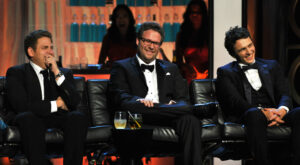Even for this recovering comic-book fan who left the community two decades ago, it’s impossible to escape the Marvel Comic Universe. Reinforced by quippy banter, diversity-by-quota casting and passable CGI, its money-making “formula” has conquered the world. The strategy is straightforward: conjure enough comics-related content to draw casual viewers in, yet never too much to risk challenging or alienating them.
One such casual — my cousin — has an approach to the MCU that embodies this form of “detached involvement”. He buys tickets to each new release, not for the cinematic journey but for the shared cultural moment. He engages with the films peripherally, often multitasking on his phone, sometimes snoozing or even leaving to eat a meal in his car. He only goes so he can watch the post-credit bonus scenes so he can talk about them at the water cooler. To him, the rest of the film is a palatable time-waster.
Yet relying on this was never going to be enough — and finally the Marvel Universe is starting to unravel. Its latest instalment, The Marvels, which reportedly cost $250 million, looks set to be a flop, joining the ranks of its other failures this year, Ant Man and The Wasp. Meanwhile, one its new stars, Jonathan Majors, whose portrayal of the time-bending villain Kang the Conqueror was intended to revitalise its brand, now faces domestic violence charges.
Marvel’s imperilled big-budget approach to superhero cinema is a far cry from my comic-crazed youth, spent in the rolling hills of rural Pennsylvania and the tidewater of North Carolina. Back then, collecting comics was more than a hobby; it was a rite of passage. I remember the visceral thrill of the hunt, driving from town to town, seeking the next instalment of narratives plotted by unsung creators such as Mark Gruenwald and Jim Starlin. These stories — particularly Starlin’s multi-part, multi-crossover Infinity Gauntlet saga — wielded a raw energy that their cynical deployment in subsequent movie adaptations could scarcely capture. In the pages of Starlin’s decades-spanning magnum opus, characters were not just avatars of power but embodiments of philosophy and human frailty. Thanos, with his nihilistic love affair with Death, was a villain of Shakespearean complexity, his every move in pursuit of power a stroke in a grand, dark saga of narrative ambition.
Crucially, these quests weren’t crafted for universal accessibility on the big screen; they were a haven for us nerds, a testament to our dedication to trivia, continuity, backstory, and our little imagined community. And as soon as they were repackaged into a blockbuster formula, they alienated those of us for whom every detail was a breadcrumb on the trail to the heart of a vast and intricate universe — our universe.
My pilgrimages to San Diego’s Comic-Con from 1998 to 2004 charted a similar journey from niche to mainstream. With each visit, the infiltration of Hollywood became more pronounced. The Comic-Con I first stepped into was a labyrinth of cardboard boxes overflowing with dog-eared comics, a place where the most valued currency was knowledge of back issues rather than the sheen of new video games or action figures. The comic vendors, custodians of this lore, guided us to hidden gems and long-sought-after back issues. Artists and writers, the unheralded architects of worlds and weavers of dreams, sat slump-shouldered at cluttered tables, ready to discuss the art of storytelling with anyone who held a passion for the craft.
As the years progressed, however, the tide began to go out. One could watch, almost in time-lapse, as the old guard of vendors began to vanish, their places taken by the glimmering displays of upcoming blockbusters and the latest video-game tie-ins. Promotional materials, once modest handouts, grew into towering banners and ostentatious set pieces. Discussions of Jack Kirby’s artistry and the nuances of his Fourth World saga were edged out by panels dominated by sound bite-spewing celebrities and sneak peeks of next summer’s tentpoles.
By 2003, the transformation was nearly complete. The convention floor, once a haven for the comic faithful, became a temple of multimedia franchising meant to captivate not just fans, but a global audience. And yet, the Comic-Con of that era still retained vestiges of its roots — the sight of cult icons such as a then-controversial Kevin Smith, who mingled with fans in a way that would seem alien amid today’s polished celebrity walkthroughs.
But this evolution wasn’t just about a changing industry; it was personal. It marked the end of an era when conventions were a crucible for forging individual identities within the collective of fan culture. Each of us, clutching our own satchel of back issues, could craft a unique persona built on the esoteric knowledge of story arcs, character histories and creator biographies. Two decades ago, you could count on your fingers the number of individuals who could navigate the complex mazes of various crossovers — but when you met them, it was like meeting a brother.
And then came the beginning of a new, albeit less intimate, chapter. Soon everyone would get to be a vague Captain America fan, clad in a shirt with his logo, without knowing any of the hundreds of unique tales that Mark Gruenwald had told about the character. It’s a bitter pill to swallow, considering that Starlin, one the Greats, did not attain vast wealth from his creation due to the nature of work-for-hire agreements.
As for the future of comics, can Marvel reclaim its former glory? While Disney, with its billions invested, might be hoping for a resurgence, it’s hard to see what it might look like. Despite Marvel’s continued efforts to extract fresh concepts from its comic division, the process seems strained. Currently, its loss-leading print division is going through yet another of its frequent “reboots” — a laborious effort that feels more like a tired publicity stunt than a thrilling narrative reset. Timeless, a new series designed to lay the groundwork for Marvel’s forthcoming tales, is set in a dystopian future that features a showdown between “Power Man” and “Immortal Moon Knight”. Such a trite narrative, for all its attempt at grandeur, smacks of desperation — a flamboyant plea for fans to hold on just a little longer in the hope that we’ll have something else for you, another place to park your money.
But perhaps it also speaks to the only way forward for Marvel: to see its decline not as a cause for mourning, but an opportunity for a reinvigoration of creativity. After all, comics still possess the potential for remarkable storytelling — provided the creators’ vision is given centre stage. Consider Amazon’s admirably faithful adaptation of Invincible, the blood-and-guts superhero story that catapulted its creator Robert Kirkman into the limelight. Or take Adi Shankar’s The Guardians of Justice, an overlooked Netflix jewel that makes Watchmen seem practically pedestrian. It was a spectacle of creative freedom, one that somehow attracted an extraordinarily diverse cast without pandering to the patronising, focus-grouped tropes of the big studios.
And outside of Marvel’s studios, the brilliance within the superhero genre also still sparkles. Japan is leading the way here — in the extraordinarily inventive manga of My Hero Academia and One-Punch Man, both flourishing under the stewardship of their Japanese creative teams rather than corporate interests.
Yet perhaps the greatest solace can be found closer to home. More than anything, the twilight of Marvel reminds me of the death throes of another genre: the Western. And how did that end? In Clint Eastwood’s Unforgiven and David Milch’s Deadwood — masterpieces of genuine passion rather than commercial viability.
Disclaimer
Some of the posts we share are controversial and we do not necessarily agree with them in the whole extend. Sometimes we agree with the content or part of it but we do not agree with the narration or language. Nevertheless we find them somehow interesting, valuable and/or informative or we share them, because we strongly believe in freedom of speech, free press and journalism. We strongly encourage you to have a critical approach to all the content, do your own research and analysis to build your own opinion.
We would be glad to have your feedback.
Source: UnHerd Read the original article here: https://unherd.com/



